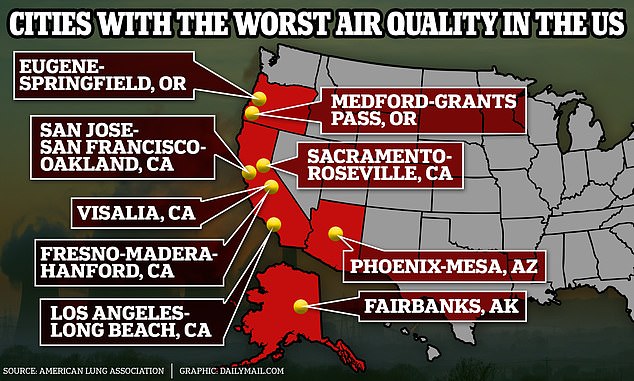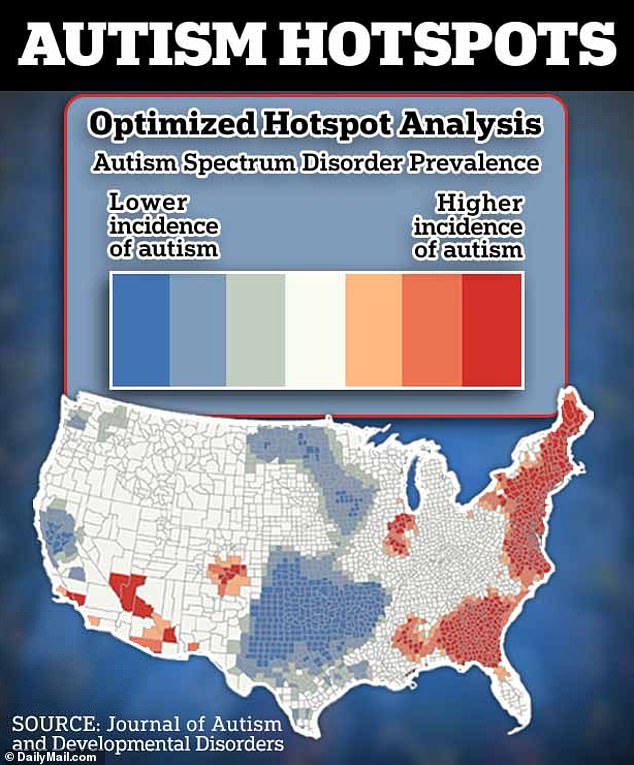A map has revealed autism hotspots in the United States for the first time.
Rates of the disorder have nearly tripled in children and young adults in the past decade, partly because doctors are better at diagnosing it.
But that doesn’t tell the whole story: A review earlier this week highlighted air pollution as a possible major factor.
Now, a study has revealed how American rates of autism in children are disproportionately high in the Northeast and Southeast.
Worchester County in Massachusetts and Chesterfield County in South Carolina, there were as many as 8.1 percent of children with autism, or one in 12. There were also hotspot clusters around major cities like Los Angeles and Chicago.
Researchers say these differences are mainly due to critical areas having better access to hospitals or research centers, making diagnosis easier.
But there may also be environmental and demographic factors. Many of the hotspot counties also had children from minority and low-income families, who have been more likely, in recent years, to be diagnosed with the disorder.
The researchers took data from approximately 70,000 children and applied what they found to every county in the United States. They then estimated the highest levels of autism as hot spots, designated in red, and estimated the lowest levels of autism as cold spots, designated in blue.
Autism spectrum disorder is a developmental condition that affects the way people interact with others, communicate, learn, and behave. National reports say that approximately one in 36 children has autism.
Understanding which regions of the country have a higher number of people with autism could help researchers understand what outside influences are contributing to diagnoses.
In 2023, researchers from the University of South Carolina addressed this topic in their article published in the journal Journal of Autism and Developmental Disorders.
They estimated autism rates in every county in the United States by analyzing data from 700,000 children.
The researchers obtained information from the National Children’s Health Survey, which asks parents to report on the health of their children between the ages of five and 17.
The survey randomly selected households within each state and called them and asked them, among other questions, if their child had been diagnosed with autism.
They also noted information about their race, sex, age and other health conditions, such as ADHD.
After obtaining this data set, the researchers used small area estimates to apply the patterns they observed to the entire country.
They found that 3.29 percent of American children may have autism, slightly higher than the CDC’s 2023 model that put the rate at 2.8 percent.

The American Lung Association ranked the top cities suffering from the worst air quality in the U.S., affecting approximately 131 million Americans.
They found that girls had lower rates of autism than boys, with 1.38 percent of girls diagnosed and 4.58 percent of boys diagnosed.
Meanwhile, 3.82 percent of Black children were diagnosed, compared to 3.36 percent of Hispanic children and 2.87 percent of white children.
They found hot spots in the Southeast, East Coast and Northeast. Rates were specifically high in New Jersey, ranging from 2.6 to 8.1 percent of the total child population.
Although the Southwest as a whole was considered low in autism, researchers said there were small clusters of high diagnoses around Los Angeles and Las Vegas.
Autism rates were especially low in the Texas Panhandle and in Oklahoma, where access to health care is notoriously difficult.
The researchers found that in areas around California, the rates corresponded to autism diagnosis trends based on family income.
In general, overall autism rates in wealthy white children have been declining, while autism rates in poorer or middle-class white children have been increasing.
According to the researchers, this could have to do with greater health care opportunities for less well-off families or greater awareness.
Poorer families are also more likely to suffer pregnancy complications and be exposed to air pollution, two factors that can increase risk.
According to a 2024 report from the American Lung Association, some of the most polluted cities include Los Angeles and Long Beach in California, Phoenix and Mesa in Arizona, and Denver and Aurora in Colorado.
Some of the cities flagged as hot spots by University of South Carolina researchers also have high rates of autism, such as Los Angeles, but not all do.
Dr. Haitham Amal, head of the Department of Neuromatics, Cell Signaling and Translational Medicine Laboratory at the Hebrew University of Jerusalem, recently published a paper attempting to explain this increase.
Between 40 and 80 percent of autism cases are thought to be related to inherited genetic mutations, but Dr. Amal’s new research has suggested a complex interplay of genetics and environment as contributors to the diagnosis of autism.
The paper found that people with genes linked to autism are more likely to develop it if they are exposed to pollution in utero or early childhood.
Scientists have not concluded that air pollution can cause autism. However, the topic has been increasingly studied as autism rates rise globally.
Dr. Amal’s new research, which focused on four different types of air pollutants, including natural gases and those produced by manufacturing and burning fuel, can reach the bloodstream when inhaled.
From there, they can cause changes in the developing brain in several ways: by causing inflammation that affects the way the brain develops or by decreasing the amount of chemicals the brain produces, Dr. Amal and his team said. .
Similarly, previous research from Harvard University’s school of public health has linked exposure to an air pollutant called particulate matter to autism.
In these types of studies, researchers find it difficult to rule out the influence of other factors that could distort the data, such as diet, smoking, or exercise habits.
This is a problem behind many similar studies linking autism to air pollution, said Amy Kalbrenner, an environmental epidemiologist at the University of Wisconsin. American scientist.
Dr Kalbrenner said: “It’s the same weakness as other studies (on environmental pollutants and autism). They’re using an EPA model, which estimates what comes out of factories and traffic and comes up with an estimate of the pollution.”
However, scientists also warn that the increase in autism diagnoses may be partly attributed to increased awareness of the condition.

